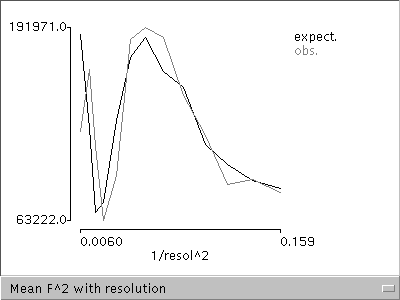
|
Kevin Cowtan
The CCP4 `dm' package is widely used for phase improvement calculations, largely because of its automation and ease-of-use. Over the past year a number of improvements have been made, in terms of the underlying techniques, as well as the user interface. The most significant of these improvements are described here.
For this phase combination step to take place, the modified phases must be replaced by a probability distribution. The two distributions may then be multiplied, to provide a new (hopefully sharper) distribution. To convert the modified phase to a phase probability distribution, the error in the modified phase must first be estimated. This is a problem which has already been tackled for phases from incomplete models by the sigma-a method (Read, 1986), by which the error in the phases is estimated from the difference between the observed and modified magnitudes.
For the combination of phase probability distributions to be valid, they must contain information from independent sources. In density modification calculations however, phase information from the experimental phasing is combined with phase information from the modified map, which itself is calculated from the experimental phasing. Clearly the two sources of information are not independent, thus the existing phases are reinforced and the phase errors underestimated. The result is that the FOMs from density modification calculations are seriously overestimated. The resulting bias cripples subsequent density modification procedures, and can lead to actual errors in the model if used for phased refinement.
The solution to this problem is to obtain the density modified phases from a source which is independent from the initial phases.
The reflection omit scheme is therefore constructed in the following manner. A set of reflections are set to zero. A map is then calculated. Density modification is applied to the map, and it is back-transformed. The modified phases are then stored only for those reflections which were not used in the initial map. This process is repeated, omitting a different set of reflections, until modified phases are available for all the phases.
This method is successful in reducing the phase bias, but it has two disadvantages:
Histogram matching and other density modifications present more difficulties. Firstly, histogram matching is a non-linear modification, and so it is not necessarily clear that the approach will work at all. Secondly, attempts to calculate a theoretical value for gamma fail consistently.
An alternative approach has been developed in `dm' version 2.0. In this approach, two initial maps are calculated, one with the current data, and one with the current data plus a small `noise' signal. Density modification is applied to both of the maps, and the resulting map coefficients are compared. The level of the noise signal in the modified map as a fraction of the initial noise signal provides an accurate estimate of the linear dependence between the initial and modified maps, and thus of gamma. The noise-free map may then be corrected using this value of gamma. An additional benefit of this approach is that gamma may be estimated for subsets of reflections, or as a function of resolution.
This method has been applied to histogram matching. In practice the linear approximation is sufficient and the resulting phases virtually unbiased. Before bias correction it was thought that histogram matching was a less powerful (but complementary) approach to solvent flattening. Once proper bias correction is introduced, it becomes obvious that histogram matching is actually a far more powerful phase constraint than solvent flattening, but had previously appeared weaker because it was more subject to bias.
The perturbation-gamma correction is much faster than the reflection omit approach, and introduces no noise into the resulting maps. As a result it is now the default method for all density modification calculations.
After a single cycle of density modification, the phase errors estimates are found to be as good as the initial data. However each cycle of density modification introduces correlation between phases, so after further cycles of density modification the phase error estimates deteriorate. However, phases from 3, 5 or 7 cycles of density modification may still be used for phased refinement in `refmac' by careful use of the `refmac' phase blurring parameter.
In version 2.0, complete control is provided over mask calculation. Input masks may be provided for the initial stages, and then recalculated as the calculation proceeds. Alternatively, auto-masks may be calculated as often or as rarely as required.
dm version 2.0.0dm reference:K. Cowtan (1994), dm: An automated procedure for phase improvement by density modification. Joint CCP4 and ESF-EACBM Newsletter on Protein Crystallography, 31, p34-38. Command InputSOLCONT 0.45 MODE SOLV HIST COMBINE PERTURBATION NCYCLE 3 LABIN FP=FP SIGFP=SIGFP PHIO=PHIB FOMO=FOM LABOUT PHIDM=PHIDM2 FOMDM=FOMDM2 CommentsDensity modifications selected:
Number of cyclesYou have specified a fixed number of cycles. This is a good choice if you have strong data or averaging, but beware that after many cycles the FOMs will be overestimated.
|
One innovation is the use of a Java applet, JLogGraph, to display log-graphs in-line in the HTML document. This saves starting up the Loggraph utility, although this may still be used for advanced formatting or printing. An (inactive) image of a JLogGraph is shown in Figure 2.

|
The HTML formatting has been implemented through a set of library routines, so that similar features may easily be added to other programs.